|
By Gretchen Schuldt The number of COVID-19 cases reported in Wisconsin state prisons soared by 1,033 cases last week, the biggest one-week increase since the outbreak began, Department of Corrections figures show. The total number of cases reported rose from 3,296 on Oct. 23 to 4,329 on Friday, Oct. 30, a 31% jump, the figures show. Five prisons reported more than 100 additional cases in a single week. Those prisons were Waupun, Stanley, Jackson, Dodge, and Green Bay Correctional Institutions. Four facilities, including Taycheedah Correctional Institution, the state's major women's prison, reported their first cases. The other three were McNaughton Correctional Center, Racine Youthful Offender Correctional Facility, and the Thompson Correctional Center. Just seven of DOC's 37 facilities did not report any COVID cases as of Friday. They are the Flambeau Correctional Center, The Grow Academy (juvenile), Kenosha Correctional Center, Oregon Correctional Center, Prairie du Chien Correctional Institution, Sanger B. Powers Correctional Center, and the Wisconsin Secure Program Facility. The Kettle Moraine Correctional Institution has the most total cases reported overall – 872 – but reported no new cases last week. Gov. Tony Evers has been sharply criticized by advocates for his failure to his powers as governor to release low-risk offenders during the pandemic. Facilities reporting increases in COVID-19 cases
0 Comments
By Gretchen Schuldt The number of positive coronavirus cases among people incarcerated in state prisons jumped by 662 last week, the largest one-week increase since those cases began to surge in August. There were a cumulative total of 2,274 coronavirus-positive tests in as of Friday, a 41% increase from the 1,612 cumulative cases reported just a week earlier. Facilities reporting increases in COVID last week are below. The first column shows the total number of cases reported as of Oct. 2 and the second column shows the total cases reported as of Oct. 9. The final column shows the one-week change. The figures show there is a growing outbreak at Oshkosh Correctional Institution and another potential outbreak at Columbia Correctional Institution. Outbreaks continued at Kettle Moraine and Dodge Correctional Institutions. Prisons reporting increases in COVID cases during the week ending Oct. 9 Gov. Tony Evers has fallen conspicuously silent on the issue of coronavirus infections among incarcerated people and staff – 577 prison staff members have tested positive and has done little to reduce prison crowding, which makes the coronavirus more likely to spread. Adult prisons are about 19% over design capacity.
In July, WISDOM, a state social justice organization, called on Evers to take specific steps to reduce crowding.
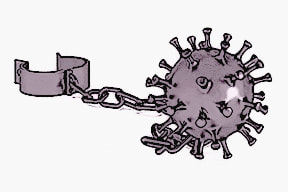 About 40% of people incarcerated at the Kettle Moraine Correctional Institution had active coronavirus cases as of Monday, according to Department of Corrections figures. There were 437 active cases in the prisons' inmate population of 1,104 as of Friday. The Oshkosh Correctional Institution reports another major outbreak with 341 active cases, according to the figures. The prison population was 1,964 on Friday, so about 17% of the inmate population had active coronavirus cases. Overall, there have been 1,612 positive coronavirus tests in state prisons since the beginning of the pandemic. Those figures include 560 positive tests at Kettle Moraine and 360 at Oshkosh, the two highest numbers in the prison system. Some people who were ill have recovered. Some are no longer in prison. Both Kettle Moraine and Oshkosh are medium security and both are significantly overcrowded. "There are so many infected they have no clue what to do," an Oshkosh inmate wrote. Gov. Tony Evers has significant power to reduce prison crowding, but has not used it.  By Gretchen Schuldt Updated 9/20/2020 to include a response from the Department of Corrections. As the number of COVID-19 cases in state prisons soars past 1,000, the Department of Corrections has begun requiring incarcerated people to pay for the masks used to slow the spread of the disease, according to inmates and their loved ones. "We here...have been informed that...we will be required to purchase our own face masks, that the DOC will no longer provide them and certainly not for free," one inmate wrote. "We will now be required to purchase a single mask for $2.50 (an allegedly one size fits all)." DOC confirmed the purchase plan for those wanting or needing more than three masks. The agency has provided at least three washable masks to each incarcerated person since April, a DOC spokesperson said in an email. "There is a plan to offer extra cotton face coverings available for purchase, if those in our care want more than the three," said the spokesperson, who did not identify himself or herself. "But there will be a limit of seven. These could be purchased by those in our care, or family members could purchase for them." Some 1,053 prison inmates and 81 staff members had tested positive for the coronavirus as of Friday. While $2.50 may not sound like much, some inmates simply have no money, others have financial obligations such as victim restitution or court surcharges, and others have extremely low-paying prison jobs. "Nothing in this policy makes any provision, that I am aware of, for the many prisoners who are indigent and unable to purchase these masks (of whom their are many),"the inmate wrote. "The mask must be purchased from the 'approved vendors'...all of which are notorious for hugely marking up the prices of all of its products...." the inmate said. Another inmate said, as have others, that his institution is not removing from the general population incarcerated people who test positive for coronavirus. The inmate said a nurse told him not to worry about getting tested because "staff was not moving anyone that tests positive. I'm like, 'WHAT!' I said 'Well then, if you're not going to keep inmates that have tested positive separated from the inmates that aren't sick, what is the purpose for all the testing?!' She said, 'I don't know!'" 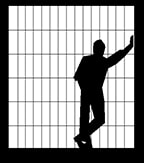 By Gretchen Schuldt The number of positive coronavirus cases continues to surge in Wisconsin state prisons and on Friday was up 70% since Aug. 21, when case numbers started their steep climb. There were 907 positive coronavirus cases in the prison system as of Friday, Sept. 11, up 373 since Aug. 21, when there were 534 cases. The number Friday was up 75, or 9%, from a week earlier, when there were 832 recorded cases, according to Department of Corrections figures. The biggest one-week increases were at Dodge Correctional Institution (up 39, to 119) and Racine Correctional Institution (up 25, to 109). There also have been 244 positive coronavirus cases of DOC staff members. David Liners, state director of WISDOM, a state social justice organization, urged members of the public Monday to contact their legislators about the crisis. "Help us get the governor's attention," he said in an email. WISDOM in July recommended that Gov. Tony Evers take several actions to reduce prison populations including:
"As of Sept. 14, he has not done anything," Liners wrote. "He has not even made a single public statement of his concern." Meanwhile, a person incarcerated in a facility with an outbreak attributed it, at least in part, to a coronavirus-infected person who was transferred there. "He was not tested prior to being moved here..." the inmate wrote. "He has been on this unit infecting people. This young man was asymptomatic. Last night they moved the young man back to...quarantine. However, the man the kid was in with was not placed on quarantine. He was left on the unit to possibly infect more people here...." He continued: "There is no further testing going to be done. The HSU (Health Services Unit) is doing temperature checks and asking if the person is experiencing symptoms. So if the inmate does not-self report because he doesn't want to go to quarantine, there is no way for them to know in a timely manner and in the case of the young man, who was asymptomatic, the temperature checks would not have revealed anything. So the long and short of it is that there is no way they can stop the spread with the current level of 'health' care the prison is providing." WJI is not naming the institution to protect the identities of the writer. Institutions still reporting no cases are Copper Lake/Lincoln Hills School, Flambeau Correctional Center, Fox Lake Correctional Institution, Grow Academy, John C. Burke Correctional Center, Kettle Moraine Correctional Institution, McNaughton Correctional Center, Oakhill Correctional Institution, Oshkosh Correctional Institution, Prairie du Chien Correctional Institution, Robert E. Ellsworth Correctional Center, Sanger B. Powers Correctional Center, Stanley Correctional Institution, Taycheedah Correctional Institution, Thompson Correctional Center, Winnebago Correctional Center, and Wisconsin Secure Program Facility.
 By Gretchen Schuldt The number of positive coronavirus cases in the state prison system jumped by 56%, in just two weeks, Department of Corrections figures show. There were 534 positive cases on Aug. 21 and 832 cases on Friday, Sept. 4, an increase of 298, the figures show. The largest increase was recorded at Green Bay Correctional Institution. There were 185 incarcerated men who tested positive as of Aug. 21 and 270 positives on Friday, up 85. Other significant increases were recorded at the Racine Correctional Institution (up 66, from 18 to 84), Dodge Correctional Institution (up 55, from 25 to 80), New Lisbon Correctional Institution (up 41, from 8 to 49), Kettle Moraine Correctional Institution (up 30, from 7 to 37), and the Milwaukee Women's Center, up 17, from 3 to 20. "For a while I was at least able to say the staff here is at least keeping us fed but things have gotten so bad that today everything came to a head!!" one Green Bay inmate wrote. For the past week here they've trying to feed us old moldy food and the portions are literally the size of two spoons!!" "Yesterday our dinner was four crackers and three meat balls, I mean literally that was our dinner!!" he said. "Today they gave us a small Styrofoam bowl of soup and two pieces of bread, I'm sad to say the prison turned into an insane asylum!! Guys got so fed up that they were throwing their food out of their cells at the walls and they were kicking the doors and screaming at the top of their lungs so for a good three hours...and staff refused to come around so there was food dripping off the walls and actually there still is food dripping off the walls because they refuse to come clean it up!!" And another Green Bay inmate wrote: "For lunch yesterday we got a Styrofoam tray with an ice cream scoop's worth of 'chicken salad' and four ounces of peas. That's it. This is becoming the norm now. When inmates write to the kitchen about they are told it is within nutritional standards. At breakfast today we got a small bowl of cereal and a small piece (approx. 2"x 2") of 'coffee cake' An object that can only be described as being related to 'hardtack.'" "People are getting sick and not being removed from general population." While religious volunteers and family visitors are not allowed in the prison because of the pandemic, contractors are inside installing cameras, the inmate said. The contractors are not social distancing themselves from those incarcerated, he said.
As for those sick, he said, "They quarantine only those who develop extreme symptoms that needs direct medical attention. The dorm alone has over 60 infected people, which will be a matter of time before the entire dorm is infected." "We are hungry and tired," another inmate wrote. "People are getting sick and not being removed from general population. According to staff there is no room to house them separately. But somehow they're finding a way to clear out 16 cells at a time to put in new sinks and toilets." 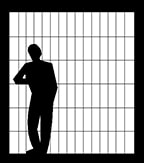 Recent heat spikes are making life harder for those incarcerated and working in the state's prisons, as the four inmate testimonials below show. They have been edited for length and clarity and to protect the writers' identities. Hey, starting a movement of free speech against cells being too hot in heat advisories. I call it "#I can't breathe cause our cell is too hot." A lot of inmates are super mad and pissed off because our cell are hot boxes with no air flow or breeze coming through. Inmates crack their doors because it's the only way to get a breeze in your room or air flow. Some guards are very caring and will let this happen, but others will enforce the closed door policy because their hand was forced and say if doors aren't closed, turning cells into hot boxes, you will get a ticket. I feel very bad for the elderly and people with health problems. They are the ones that suffer the most. Inmates have had heat exhaustion and I'm sure heat stroke here. The ambulance comes here a lot. Inmates have complained and were told nothing will be done about it. As some staff sit back and enjoy air-conditioning in their offices, inmates suffer from heat exhaustion in their rooms. I see a HUGE lawsuit coming when someone falls out. Inmates and staff are both sick of nothing being done. There's not good air flow on the units, either. One person told me today that the warden here said its too expensive to fix the problem to bring air flow to the cells. So now inmates suffer in their cells. Who's responsible if someone falls out in their cell from the heat because nothing was done? It's like leaving someone in a locked car to fry – it's just not right. I'm just sitting in my cell writing a letter doing nothing. I get soaked in sweat just sitting there. I hope this goes to the media, Madison, higher ups, news stations. This is inhumane and torture punishment. Ask everyone to share their stories about being hot boxed in their cell and what they did to get change. "It's like leaving someone in a locked car to fry – it's just not right." We have to wear sweatpants for 7½ hrs a day. All of the previous week (July 7 to July 10) has been horrendous. At 7 a.m. the outside temp would be 67°F; however, once in the building the temp on thermometer stated 90°F. There are box fans and a couple industrial (36" fans) none of which really do anything unless you are directly in front of them. Most of the working spaces you would sweat just standing still. On top of this we are required to wear a fabric mask for the entire 7½hrs. These masks do not breathe well. They offer us ice and water to keep cool; however, in that kind of heat it lasts maybe 10 minutes. We do get three breaks a day; two 10 minute and one 15 minutes. I myself have developed a sweat rash that covered 80% of my back from the chair I sit in. We have asked for the ability to wear shorts during these times. In response we were told that wearing shorts is unprofessional for a work place. This has become a common excuse throughout the last 14 years that I have been locked up; we must wear out shirts tucked in to look professional at all times. Mostly every day, there is a 'Heat Advisory' in effect which shuts down most movement such as work, recreation, track (any exercise/cardio) and courtyard activities. I can't believe that we are locked into our rooms, especially when there is a legitimate heat index. We have separate day room times for the upper and lower tiers. Recreation also. When it is not our time out we are locked into our cells. This is quarantine procedure. The heat is oppressive and air does not get into the cell and circulate. The emergency call buttons are rarely answered, which creates a severe security risk. They take on average close to 11-13 minutes roughly if at all. There are many older people on the unit and they are at risk of heat stroke, fatal heart attacks and seizures. My cellmate is hypoglycemic and needs to go to HSU (health services unit) four times a day. Rarely does he get out of the cell on time. Therefore he has been denied essential medical care. There are hundreds of cases like this and they need to be brought into the light. The cell doors do not need to be double locked. We should be able to push the release button and exit if we so choose. This is a medium security facility. These actions are not necessary. (Department of Corrections) Secretary Kevin Carr needs to be made aware of these indiscretions. (Division of Adult Institutions Administrator) Makda Fessahaye doesn't seem to be too concerned with these actions either. I am hoping that by me speaking out that this will start a conversation of the utmost importance. Peoples' LIVES are literally and figuratively at stake and hang in the balance. I wanted to make the community aware of the living conditions here. We are only allowed cell cleaning once a week on Saturdays and for only 10 minutes per cell and we get timed or get a conduct report.
The cleaning supplies they have consist of generic windex and watered-down disinfectant cleaner and one mop bucket, which each cell uses and water doesn't get changed, nor does the mop head. Very unsanitary. It is extremely hot in the unit – no air-conditioning, no fans on the tiers, no circulation at all and when the sun is beaming through the window we get conduct reports if we cover the windows up to stop the burning of the sun. They also only allow us to have three small 8-oz cups a day for ice water. They won't open doors or traps to get some air. A couple inmates on my unit has had some seizures due to how hot it is. This is inhuman to make us suffer like this. Another note – when it's very hot outside they won't let us use the gym. We have outside rec which is ridiculously hot and humid but they allow the barracks to use gym everyday for multiple hours because they are minimum custody which is bullshit they shouldn't even be allowed on the same grounds as us max inmates. The crazy part Is (some areas of the prison) have air-conditioning so we don't understand why we can't get some type of air flow. They waiting to several people to die, I guess. By Gretchen Schuldt The state prison population increased last week for the second week in a row, reversing the downward trend that began when the coronavirus outbreak prompted the Department of Corrections in March to stop accepting newly sentenced inmates from county jails. DOC started accepting new inmates again June 1 and continues to do so, despite a statewide surge in coronavirus cases. The number of incarcerated adults rose from 21,360 on July 10 – the low point in the state prison population this year – to 21,368 on July 17 and 21,390 on Friday. The female prison population has been on the rise since June 26, when it hit a coronavirus-era low of 1,339. It rose in each subsequent week. The male population of incarcerated adults did not increase until until last week. The overall prison population remains 9% lower than it was on March 6, early in the pandemic, when it stood at 23,485. On Friday, the population was 21,390.  By Gretchen Schuldt Last week's heat wave added more miserable conditions to the carried by incarcerated people already struggling with limitations and hardships attributable to the coronavirus pandemic. It hasn't been an air-conditioned holiday for staff, either. The inmate testimonials below have been edited for length and clarity and to protect the writers' identities. Intel on temperature...day rooms bottom tier 86.9°…. It is cruel and unusual punishment to both the staff and the inmates of the prisons having a sustained temperature so high, not to mention a extreme health hazard to already susceptible-healthed inmates. Last few years we have had visitors collapse with heat shock in visitation! I have diabetes and heart and kidney diseases, and diabetics are not supposed to sweat profusely for extended periods due to how it crushes a person’s chemistry! Elderly are even more vulnerable with age- related issues that make them weaker to extreme temperatures! The environment is gunna continue to heat up for years to come. I have 8 months till my release and I ain’t trying to die here! Now combine all this COVID shutdown and close quarters is making the situation more dangerous for staff and inmates. We get told people don’t have air conditioning at home, (but) homes ain’t made out of heat-conducting materials like steel and concrete in completely open spaces to absorb solar radiation all day, making it a furnace! This is a very serious issue that people need to know! *** With the weather being so hot & humid, our ice machines run out quickly. This is partly due to self-centered selfish inmates filling pitchers and large bowls of ice. This is also partly because the ice machines are not designed for this many people. So once the machine runs out, within 20 minutes of being opened back up, we are supposed to get a bucket of ice. However, we are limited to 2 buckets per shift. Again, pitchers and large bowls are filled, leaving the older men and handicapped men with nothing. One of these men just had a heat stroke last night. There are times staff refuse to even get the buckets out of the freezer in the servery. Its bad enough our rooms turn into sweat boxes and we can’t even prop the door open for just a little breeze, we can’t partly cover our windows to block out the blazing sun. With being under “modified movement” still we are still stuck in these death boxes for 21+ hours a day with no relief. A small fan blowing nothing but hot air does not help keep you cool. We have AT LEAST another week of this weather and August isn’t even here yet. Because of how hot it is guys are having issues sleeping. This heat and lack of sleep is also causing short tempers. Arguments are daily, I’ll guarantee you the fights will break out soon also. Extra ice, propping doors slightly open, opening the dayrooms and yards, these things will help quell the issues. When are we going back to a medium prison and away from the max? *** Boy it's been hot!
And you’ve got all kinds of COs working doubles in this heat. Guess what? Makes some of them cranky. So any little bit gets exacerbated because they are hot and tired. Now they weaponize ice. Not putting it out. Or not unlocking the ice/water machine. Why? The COs don’t even have to touch it. Inmates do all the work. When the ice/water machine gets locked up it only takes 25 minutes to fill up. Use the buckets of ice then. Now let’s talk about the doors. Most of the time we crack them open a boot width (like from big toe to pinky toe). But sometimes you get a CO who is a hater and makes us keep them closed. And there response is “a white shirt told me to.” Which is more likely than not a lie. Further more in the past I’ve been told by white shirts we can keep them cracked a boot width. There is zero air with the door closed. It is absolutely miserable in the cells with out the door cracked. Try sleeping in your shed at night when it’s hot. Be sure to keep the door shut! Here is a question: what can I do with the door cracked that I can’t do with the door shut? Nothing! This is just a way to be cruel. Especially if your cell faces west. Good God those suckers are hot! If its 90° outside (not mentioning 70 dew point) those cells are 120°. If anybody doesn’t believe me they can check any cell facing west on the front yard with a temperature gauge! I suppose we could get this fixed by working out in our cell until we fall out. Then we can say its too f---in' hot in the cells! Or one of the old guys will die. Oh yea...they get moved to HSU for the air conditioning. What a petty way to breed hate and discord in the prison! Turn on the AC! Is it October yet? *** I wanted to pass along some info about the COVID lockdown....It started on May 26th and was apparently caused by the PT that sees inmates here. She was here and met with two inmates on 5/22 and on the 26th those two inmates and there cellies were sent to Dodge for quarantine. Warden...put out a memo on the 26th instructing that all inmates wear masks when out of our rooms and that staff is supposed to wear them at all times when around inmates. Several staff members, including the superintendent...and both captains have been walking around and talking with staff and inmates without a mask. I had a convo with (a captain) on Thursday the 28th. He was about two feet away and was not wearing a mask. When I made a comment regarding it, one of the sergeants that was standing nearby got in my face and screamed at me and actually dropped the line that we're all in this together. The National Guard was here today testing all staff, including the staff and inmates. The superintendent was walking around without a mask. Today is also the first day in four days that we had a hot meal. Its been sandwiches and a salad since Wednesday night. Breakfast is cereal and white bread with pb&j and a juice. On Friday, the superintendent led a tour around the facility and no one was wearing a mask. I don't believe these were DOC people because I never saw an ID, so I'm not sure who they were. We are not being allowed any type of rec or phone calls. People without tablets have not been permitted to use the kiosk to let their loved ones know what's happening.... I want to put an ICE in about staff not wearing masks and the lack of ability for proper hygiene as far as clean clothes. However, the captains and the superintendent like to threaten and intimidate anyone who makes any kind of complaint.  Liners Liners By Gretchen Schuldt The decline in the state's population slowed markedly in the past two weeks as the state started accepting new inmates from counties, a practice it suspended March 23 in an effort to block the importation of the coronavirus into state prisons, according to state figures. The state started accepting inmates again on June 1. Because of the crowded conditions in prisons, they are considered prime sites for COVID-19 spread. The Wisconsin prison population declined by just 66 inmates during the week ending June 5 and 106 during the week ending Friday, according to the Department of Corrections. The last time the prison population decline was anywhere near that small was during the week ending March 27, when it dropped by 109 people. The overall prison population fell from 23,256 on March 6, the week before Gov. Tony Evers declared a coronavirus-related state of emergency, to 21,548 Friday, a decline of 7%. David Liners, state director of WISDOM, a justice organization, said Evers is not doing enough to reduce the risk to incarcerated people. "The governor once claimed he wanted to cut the prison population in half," Liners said. "At the moment when it is most urgent to use the powers unique to his office, he has failed by refusing to act." WISDOM is organizing a "Drive to Decarcerate" caravan to Madison on Thursday. People interested in participating can learn more and sign up here. Evers "has received warnings from the public health community," Liners said in a prepared statement. "He has gotten assurances that his power to commute sentences cannot be overturned by the legislature. He knows that there are many, many people in our prisons who are a very low risk to public safety, but who are at great risk of serious illness or death if they remain in overcrowded prisons. He knows that the virus has already begun to sweep through some of the prisons, among both incarcerated people and staff. Still, he has chosen to do nothing, and not to even address the issue."
Not included in those figures are the number of people incarcerated for reasons related to alleged violations of community supervision. There were 338 of those people locked up as of Friday. That is up 23 from the low of 315 in the weeks ending May 15 and May 22. |
Donate
Help WJI advocate for justice in Wisconsin
|
Copyright © 2024 Wisconsin Justice Initiative Inc.
The Wisconsin Justice Initiative Inc. does not endorse candidates for political office. The Wisconsin Justice Initiative Inc. is a 501(c)3 organization.
The Wisconsin Justice Initiative Inc. does not endorse candidates for political office. The Wisconsin Justice Initiative Inc. is a 501(c)3 organization.

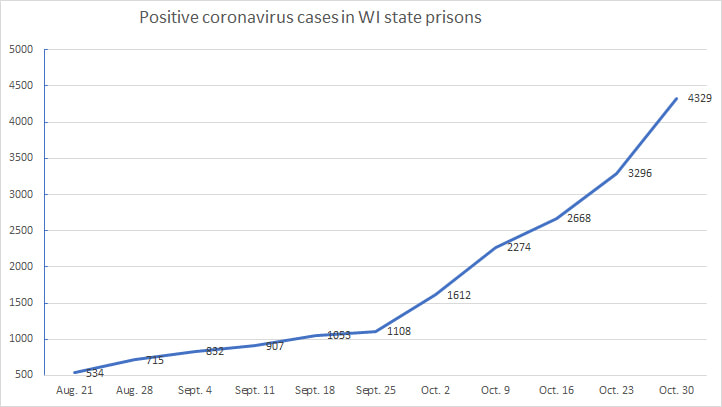
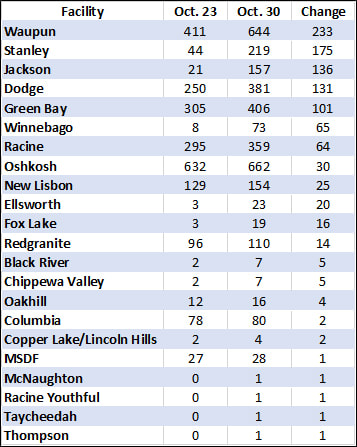
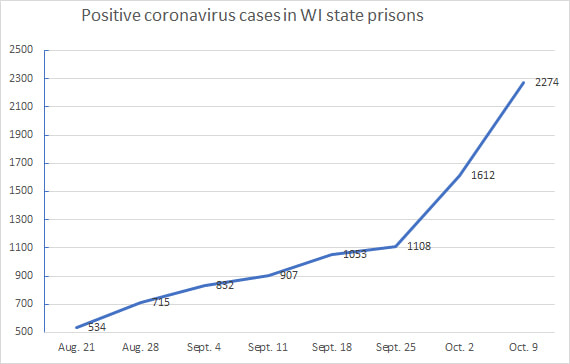
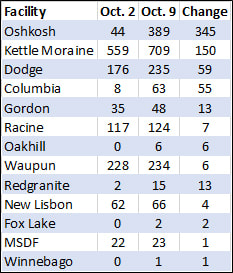
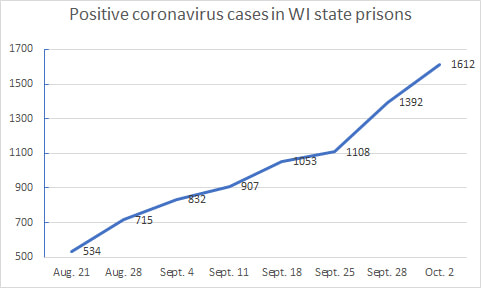
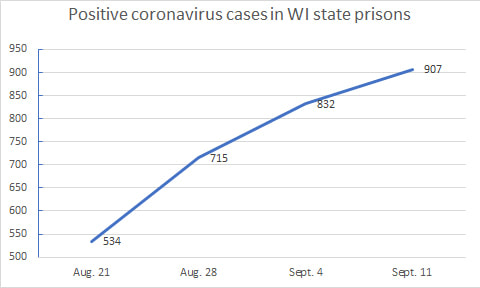
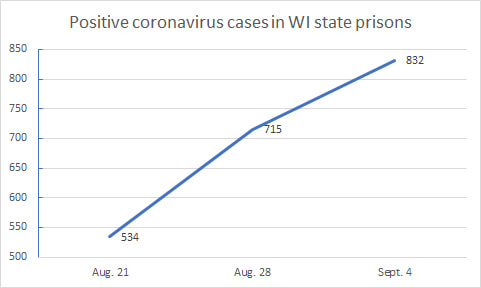
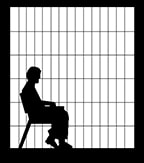
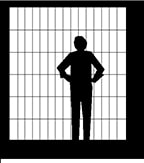
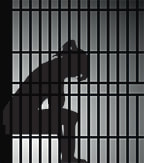
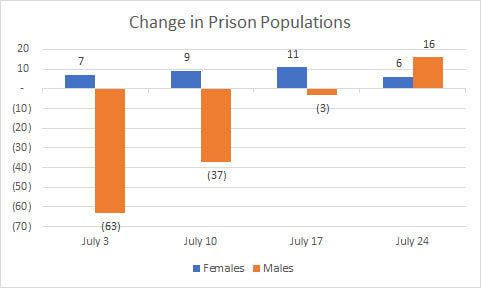
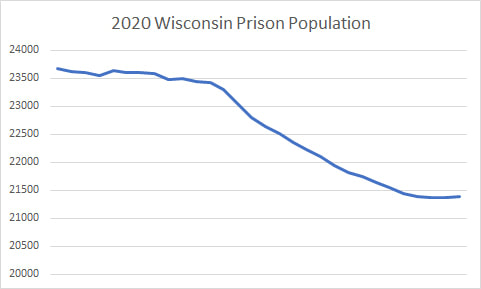
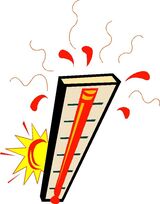
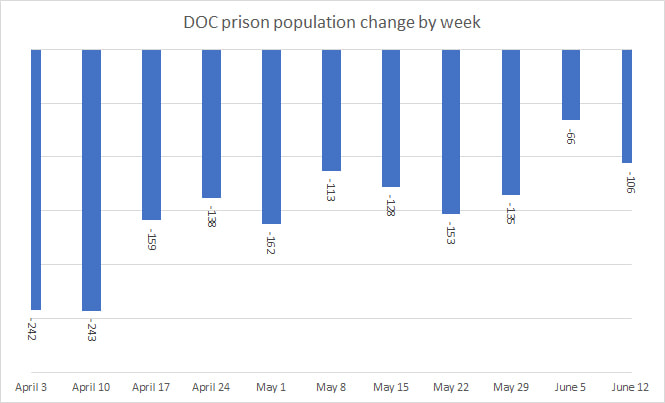
 RSS Feed
RSS Feed